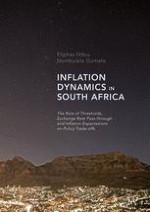2017 | OriginalPaper | Buchkapitel
3. The Output and Inflation Trade-off in South Africa
verfasst von : Eliphas Ndou, Nombulelo Gumata
Erschienen in: Inflation Dynamics in South Africa
Aktivieren Sie unsere intelligente Suche, um passende Fachinhalte oder Patente zu finden.
Wählen Sie Textabschnitte aus um mit Künstlicher Intelligenz passenden Patente zu finden. powered by
Markieren Sie Textabschnitte, um KI-gestützt weitere passende Inhalte zu finden. powered by
